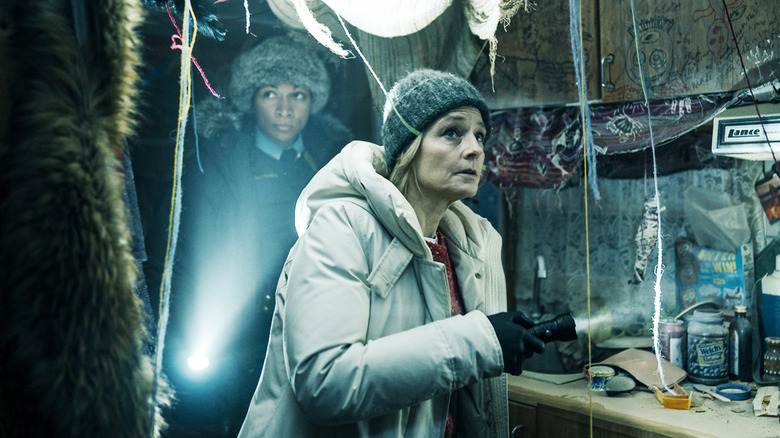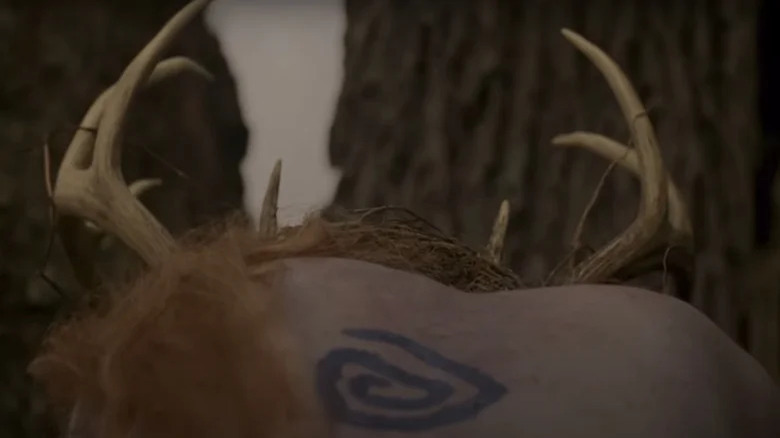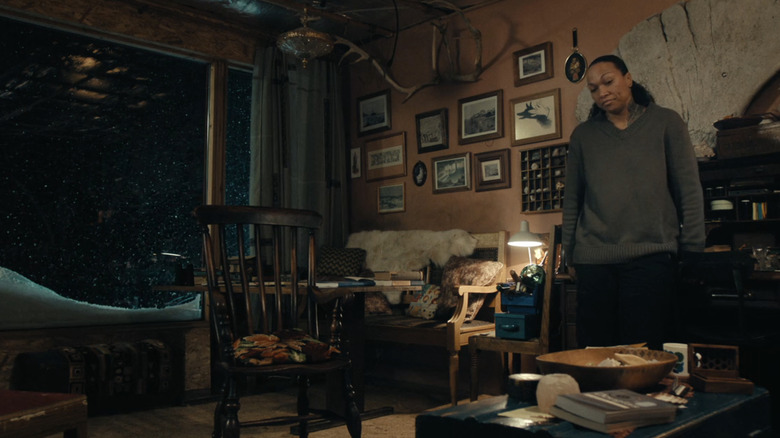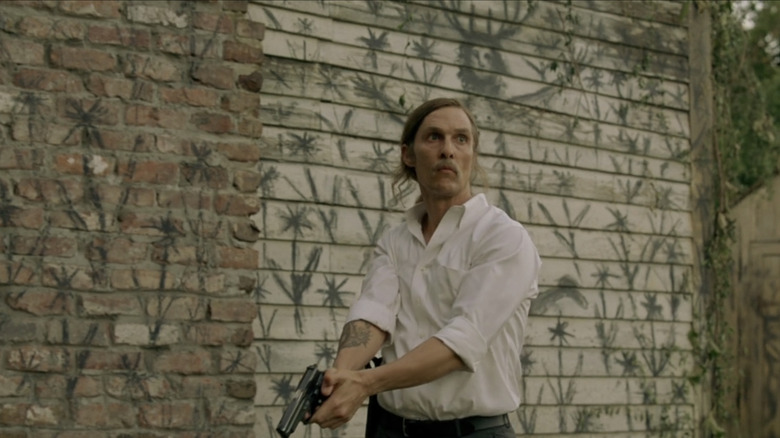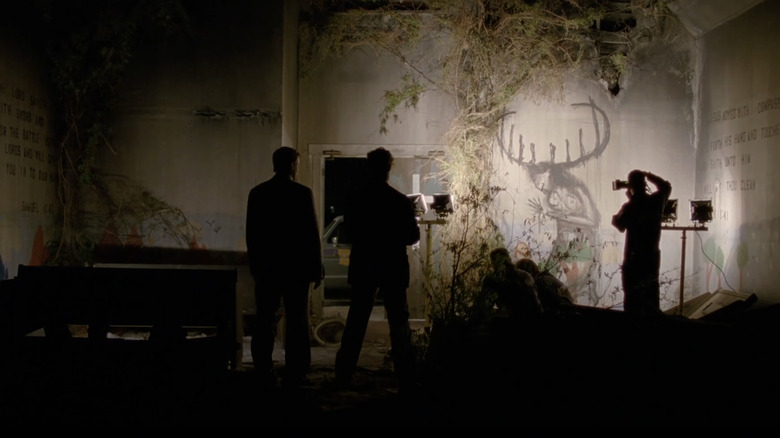The Spiral Isn't The Only Season 1 Symbolism In True Detective: Night Country
This article contains spoilers for "True Detective: Night Country."
2014's "True Detective" season 1 introduced a whole host of unique symbols, tropes, and stylistic choices to the crime procedural. It was so visually distinctive that fans have long since pined for the affecting mix of cosmic horror symbolism, occult mythology, and eclectic styles drawn from various religions native to Southern Louisiana that gave Nic Pizzolatto's original season its inescapably intoxicating atmosphere. The tone of that initial run of episodes was enhanced by director Cary Fukunaga, who shot the Louisiana setting with an impeccable eye for the inherent creepiness of its vast backwaters and ghost towns that, in Rust Cohle (Matthew McConaughey)'s words, were "like somebody's memory of a town, and the memory is fading."
This is why fans of that first season will no doubt be exhilarated by "True Detective: Night Country" and its usage of season 1 symbolism. New showrunner Issa Lòpez has crafted what is effectively a direct sequel to season 1, confirming that the ghostly figure witnessed by Fiona Shaw's Rose Agineau is, in fact, Rust Cohle's father, Travis. What's more, the cult from season 1, run by the insidious and powerful Tuttle family, is revealed to be funding the research station at the heart of the mystery in "Night Country."
All of this was foreshadowed when the trailer for "Night Country" dropped in 2023 and was replete with the same spiral symbols that were seen throughout season 1. Now, we can say for sure that these two seasons are linked. But the spiral, the Tuttle cult, and Travis Cohle are far from the only links to season 1. There's also a specific symbol from the 2014 season that's been cropping up throughout "Night Country" and is just as ominous, and perhaps even more fascinating, than the ubiquitous spiral.
'Why the antlers?'
Episode 2 of "Night Country" confirmed that, far from just being a callback or homage, the spiral symbol is central to the mystery propelling this latest season of "True Detective." The motif was first seen in the 2014 pilot episode of the show, tattooed on the back of murder victim Dora Lange. Throughout that first season, the spiral continued to appear and seemingly represented the cult carrying out these ritual killings. It also seemed to represent Rust Cohle's famous theory that "time is a flat circle," symbolizing a view of existence as time continually spiraling back on itself, repeating prior events with only very slight deviations.
Since then, show creator Nic Pizzolatto has returned to the symbol, most notably in season 3 when a documentary filmmaker points to it representing child abuse rings. Still, there was never any confirmation of exactly what the spiral was supposed to mean, and that wasn't the only symbolism in season 1 that remains mysterious. The original episodes are packed with imagery borrowed from a stunning array of cultural sources in general. One of the more intriguing examples was antlers, which, much like the spiral, are first seen adorning Dora Lange's body.
So intrigued by this macabre visual flourish was Rust Cohle that even he couldn't help but immediately ask Reggie Ledoux (Charles Halford) — one of the abusers whom Rust and his detective partner Marty Hart (Woody Harrelson) hunt down — "Why the antlers?" Of course, we never really get a solid answer to this question, as much of "True Detective" season 1 relied on mysteries going unsolved to establish an overriding sense of doom. Now, however, Issa Lòpez appears to have picked up this particular baton and, much like with the spiral, is running with it in "Night Country."
Rose echoes Rust's antler obsession
The antlers are first seen in the pilot episode of season 1, but Rust Cohle becomes fascinated with the image and, after returning to Louisiana in 2012 to try to finally solve the case, affixes a set of antlers to the wall of his storage unit (from which he conducts his one-man investigation). In "Night Country," there are direct parallels to these examples. Firstly, the new season begins by suggesting it will fulfill the cosmic horror promises of season 1, showing a herd of Elk jumping off a cliff after being disturbed by some sort of unseen force. Thus far, we're still none the wiser as to what actually happened in this scene, but you certainly can't get more explicit antler/death imagery to open the season than that.
Secondly, episode 2 of "Night Country" seemingly revealed that Rose Agineau is Rust Cohle's mother (or at least that her late husband, Travis, was Rust's father). If you take a look at the interior scenes shot at Rose's house, you'll see a pair of antlers proudly displayed high on her wall. While this seems designed to convey that Rose is a full-on badass who we now know is capable of hunting with the best of them, there's no denying the antlers high on the wall are extremely reminiscent of her (potential) son's storage unit design choices.
But that's not the end of the antler imagery in both season 1 and "Night Country." Things get downright sinister as both seasons progress, with episode 3 of Issa López's season giving us the most overt antler symbolism yet.
Episode 3 takes the antler imagery up a notch
After the gruesome discovery of the bodies in the ice, or "corpsicle" as Jodie Foster's Liz Danvers calls it in the second installment of "Night Country," episode 3 sees Danvers and State Trooper Evangeline Navarro (Kali Reis) expand their investigation into the death of the Tsalal research station scientists. This leads them to track down a former Tsalal worker by the name of Oliver Tagaq, the facility's erstwhile equipment engineer who left the station before the death of Annie K. Danvers and Navarro eventually discover that Tagaq is living in a nomad camp on the north shore and travel out to the isolated location to question him. When they arrive, the duo are shown to his house, the exterior of which is completely covered in, you guessed it, antlers.
While antlers have appeared several times in "Night Country," they seem to be a particularly foreboding symbol here, adorning Tugaq's house like some sort of memento mori warning of the evil that lurks within. When Danvers and Navarro go inside, Tagaq isn't exactly pleased to see them but he doesn't seem especially malevolent and appears genuinely surprised to learn that his former colleagues have perished on the ice. This suggests that Lòpez's use of the antler imagery is more of a general representation of Danvers and Navarro descending down a dark rabbit hole as they continue to carry out their investigation, rather than a hint that Tugaq himself is involved in the deaths of the scientists.
Interestingly enough, rather than antlers simply representing some nebulous evil in season 1, there does appear to be more to their usage in that original run of episodes. This could mean Issa López intends to elaborate on the antler symbolism as "Night Country" continues.
What do the antlers actually mean?
So what exactly is all this antler usage about, anyway? Well, this is "True Detective," which means that even when cases are solved there still aren't a whole lot of concrete answers. It's also why Issa Lòpez — a perfect fit for "True Detective," by the way — is able to rework the spiral symbol for her episodes. That said, there are some things we can say about the antler imagery in season 1.
At one point during Marty and Rust's investigation, they discover a burned-out church. Inside, they find graffiti depicting a figure with antlers that looks very similar to Dora Lange. As the season continues, the pair find serial killer Errol Childress (Glenn Fleshler) and discover on his property what appears to be an altar to the mysterious Yellow King — a figure worshiped by the cult responsible for the murders and an image borrowed by Nic Pizzolatto from Robert Chambers' 1895 short story collection "The King in Yellow." This altar is a mish-mash of human skulls, drapes, and antlers.
Fans of the show might be aware of the impressively detailed breakdown of the show's influences that appeared on Reddit a couple of years ago. In this meticulous explanation of season 1, the writer surmises that the victims of the cult "are supposed to be Angels of the Yellow King God-Spirit and they wear antlers because Antlers devote them to the Yellow King." Considering the use of antlers in the Yellow King altar, this interpretation makes a lot of sense. But what does it mean for "Night Country?" Is Lòpez just using the antlers as a foreboding image to signal the presence of evil? Or are the followers of the Yellow King cult actually involved in the death of the Tsalal researchers?
New episodes of "True Detective: Night Country" drop on Sundays on HBO and Max.
